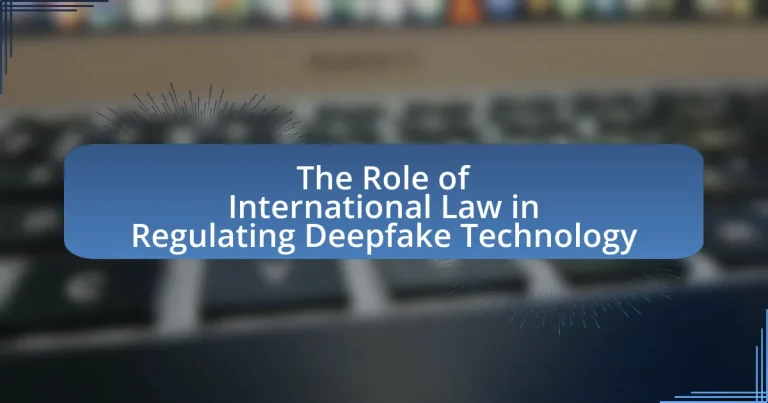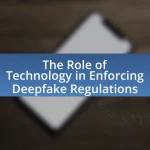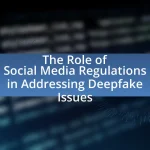The article examines the role of international law in regulating deepfake technology, highlighting its significance in addressing issues such as misinformation, privacy rights, and intellectual property. It outlines existing legal frameworks, including the Council of Europe’s Convention on Cybercrime and the European Union’s General Data Protection Regulation, which provide mechanisms for accountability and protection against the misuse of deepfakes. The article also discusses the varying interpretations of deepfake regulations across different countries, the potential harms posed by deepfakes to individuals and society, and the challenges in enforcing international law due to jurisdictional issues and technological advancements. Additionally, it emphasizes the importance of public awareness and collaboration among stakeholders to create effective regulatory measures.
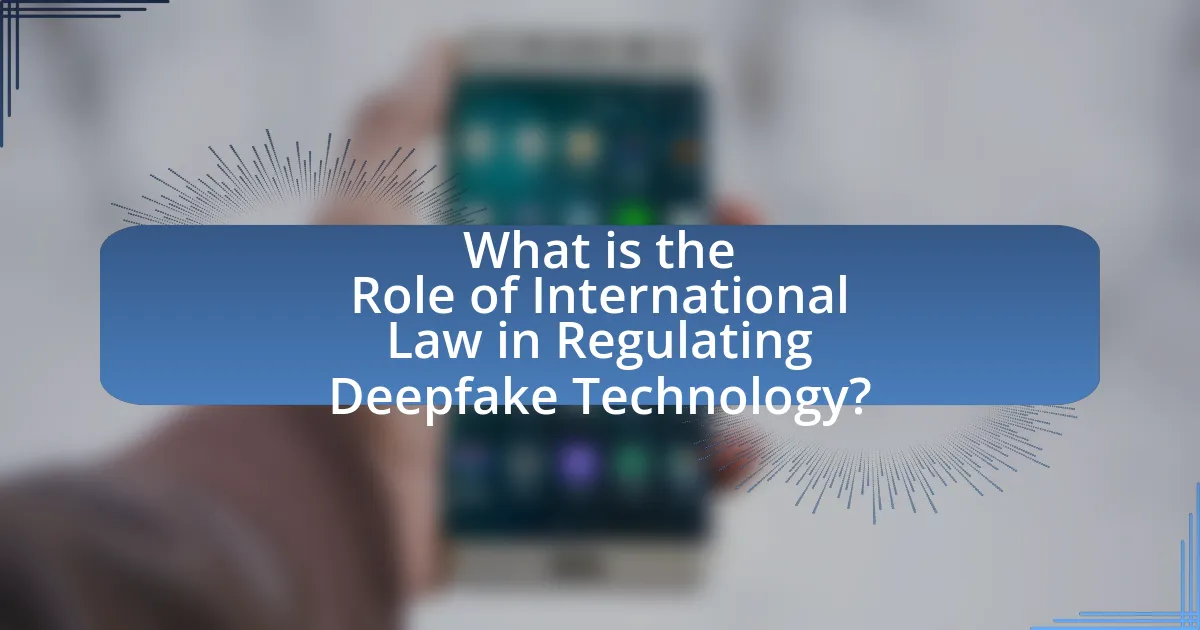
What is the Role of International Law in Regulating Deepfake Technology?
International law plays a crucial role in regulating deepfake technology by establishing frameworks that address issues such as misinformation, privacy rights, and intellectual property. These frameworks include treaties and conventions that can be adapted to tackle the unique challenges posed by deepfakes, such as the potential for defamation and fraud. For instance, the Council of Europe’s Convention on Cybercrime provides a basis for member states to cooperate in combating crimes facilitated by digital technologies, including deepfakes. Additionally, international human rights law, which protects individuals from harm caused by false representations, can be invoked to hold creators of malicious deepfakes accountable. Thus, international law serves as a foundational tool for creating standards and mechanisms to mitigate the risks associated with deepfake technology.
How does international law define deepfake technology?
International law does not have a specific, universally accepted definition of deepfake technology. However, it generally encompasses deepfake technology under broader categories such as digital manipulation, misinformation, and cybersecurity threats. Various international legal frameworks, including those addressing intellectual property, privacy rights, and defamation, can be applied to regulate the use of deepfakes, particularly when they infringe on individual rights or contribute to harmful misinformation. For instance, the Council of Europe’s Convention on Cybercrime addresses issues related to the misuse of technology, which can include deepfakes, highlighting the need for legal standards to combat their potential misuse.
What are the legal implications of deepfake technology under international law?
Deepfake technology raises significant legal implications under international law, primarily concerning issues of privacy, defamation, and intellectual property rights. The use of deepfakes can infringe upon individuals’ rights to privacy, as unauthorized manipulation of their likeness can lead to reputational harm and emotional distress. For instance, the European Union’s General Data Protection Regulation (GDPR) provides a framework for protecting personal data, which can be applied to deepfake scenarios where individuals’ images are used without consent.
Additionally, deepfakes can lead to defamation claims, as the creation and distribution of misleading content can damage an individual’s reputation. International legal frameworks, such as the International Covenant on Civil and Political Rights, emphasize the protection of reputation, which can be invoked in cases involving harmful deepfake content.
Intellectual property rights also come into play, as the unauthorized use of someone’s likeness or voice in deepfakes may violate copyright or trademark laws. The Berne Convention for the Protection of Literary and Artistic Works provides a basis for protecting creative works, which can include the original content used to create deepfakes.
In summary, deepfake technology presents complex legal challenges under international law, impacting privacy rights, defamation, and intellectual property protections.
How do different countries interpret deepfake technology in their legal frameworks?
Different countries interpret deepfake technology within their legal frameworks in varied ways, often reflecting their unique legal traditions and societal values. For instance, the United States primarily addresses deepfakes through existing laws related to fraud, defamation, and copyright, while some states have enacted specific legislation targeting malicious deepfakes, such as California’s law prohibiting the use of deepfakes for harassment or fraud. In contrast, the European Union is considering comprehensive regulations that would classify deepfakes under the General Data Protection Regulation (GDPR) and the Digital Services Act, emphasizing transparency and accountability. Meanwhile, countries like China have implemented strict regulations that require platforms to verify the authenticity of content, reflecting a more authoritarian approach to controlling misinformation. These interpretations highlight the diverse legal landscapes surrounding deepfake technology, influenced by cultural, political, and technological factors.
Why is regulating deepfake technology important in the context of international law?
Regulating deepfake technology is crucial in the context of international law to prevent misinformation, protect individual rights, and uphold national security. Deepfakes can be used to create misleading content that undermines democratic processes, as evidenced by instances where manipulated videos have influenced elections and public opinion. Furthermore, international law frameworks, such as the United Nations’ guidelines on human rights, emphasize the need to safeguard individuals from harm caused by malicious uses of technology, including defamation and privacy violations. By establishing regulations, countries can collaborate to address the cross-border implications of deepfakes, ensuring accountability and promoting ethical standards in digital content creation.
What potential harms do deepfakes pose to society and individuals?
Deepfakes pose significant harms to society and individuals by facilitating misinformation, damaging reputations, and undermining trust in media. Misinformation can lead to political manipulation, as seen in instances where deepfakes have been used to create false narratives about public figures, potentially influencing elections and public opinion. Additionally, individuals can suffer reputational damage when deepfakes are used to create non-consensual explicit content, leading to emotional distress and social stigma. The erosion of trust in media is evidenced by a 2020 study from the Pew Research Center, which found that 51% of Americans believe deepfakes will make it harder to tell real news from fake news. These harms highlight the urgent need for regulatory frameworks to address the implications of deepfake technology.
How can international law mitigate the risks associated with deepfake technology?
International law can mitigate the risks associated with deepfake technology by establishing comprehensive legal frameworks that address the creation, distribution, and use of deepfakes. These frameworks can include regulations that define and prohibit malicious uses of deepfake technology, such as misinformation, defamation, and identity theft. For instance, the Council of Europe’s Convention on Cybercrime provides a model for international cooperation in combating cybercrime, which can be adapted to include specific provisions against harmful deepfake applications. Additionally, international treaties can promote accountability by requiring member states to implement laws that penalize the misuse of deepfakes, thereby deterring potential offenders and protecting individuals’ rights.
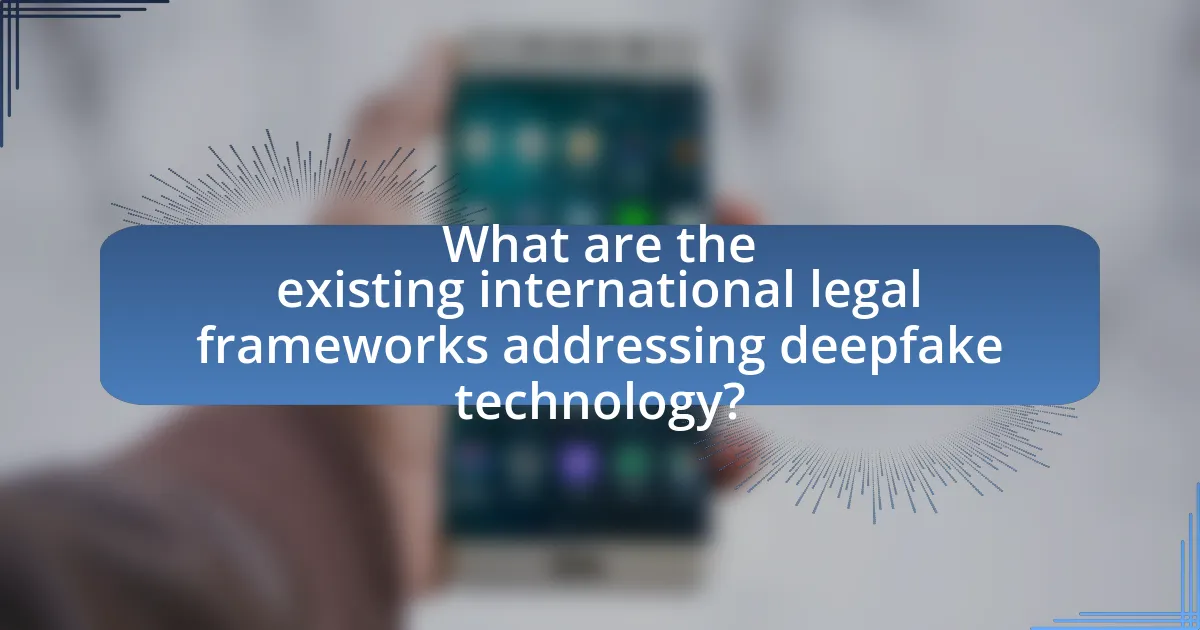
What are the existing international legal frameworks addressing deepfake technology?
Existing international legal frameworks addressing deepfake technology include the Council of Europe’s Convention on Cybercrime, the European Union’s General Data Protection Regulation (GDPR), and the United Nations’ initiatives on digital rights. The Council of Europe’s Convention on Cybercrime provides a legal basis for combating cybercrime, which encompasses the misuse of deepfake technology. The GDPR addresses data protection and privacy concerns, relevant to the unauthorized use of personal data in deepfakes. Additionally, the United Nations has been working on frameworks to protect human rights in the digital age, which includes the implications of deepfake technology on misinformation and privacy. These frameworks collectively aim to regulate the ethical and legal challenges posed by deepfakes on a global scale.
Which international treaties and agreements are relevant to deepfake regulation?
The international treaties and agreements relevant to deepfake regulation include the Council of Europe’s Convention on Cybercrime, the European Union’s General Data Protection Regulation (GDPR), and the United Nations’ International Covenant on Civil and Political Rights (ICCPR). The Council of Europe’s Convention on Cybercrime addresses issues related to computer crimes and electronic evidence, which can encompass deepfake technology. The GDPR provides a framework for data protection and privacy, impacting how deepfakes can be created and shared. The ICCPR emphasizes the protection of individual rights, including the right to privacy, which is relevant in the context of deepfake misuse.
How do these treaties address the challenges posed by deepfake technology?
Treaties addressing deepfake technology challenges focus on establishing legal frameworks for accountability and protection against misinformation. For instance, the Council of Europe’s Convention on Cybercrime emphasizes the need for member states to criminalize the malicious use of deepfakes, thereby promoting legal recourse for victims. Additionally, the European Union’s Digital Services Act mandates platforms to take responsibility for harmful content, including deepfakes, ensuring that they implement measures to detect and mitigate such technologies. These treaties collectively aim to enhance international cooperation and provide a structured approach to combat the risks associated with deepfake technology, thereby reinforcing legal standards and protections.
What role do international organizations play in regulating deepfakes?
International organizations play a crucial role in regulating deepfakes by establishing guidelines and frameworks that address the ethical and legal implications of this technology. For instance, the United Nations Educational, Scientific and Cultural Organization (UNESCO) has initiated discussions on the need for global standards to combat misinformation, including deepfakes, emphasizing the importance of media literacy and responsible use of technology. Additionally, the European Union has proposed the Digital Services Act, which aims to hold platforms accountable for harmful content, including deepfakes, thereby creating a regulatory environment that encourages compliance and accountability among tech companies. These efforts illustrate how international organizations are actively working to create a cohesive approach to managing the challenges posed by deepfake technology.
What are the gaps in current international law regarding deepfake technology?
Current international law lacks comprehensive regulations specifically addressing deepfake technology, leading to significant gaps in accountability and enforcement. Existing legal frameworks, such as those governing intellectual property and privacy, do not adequately cover the unique challenges posed by deepfakes, including misinformation, identity theft, and defamation. For instance, the absence of a clear definition of deepfakes in international treaties creates ambiguity in legal interpretations and enforcement actions. Furthermore, the rapid evolution of technology outpaces the legislative process, resulting in outdated laws that fail to address the nuances of deepfake creation and distribution. This gap is evident in the limited application of existing laws to combat the malicious use of deepfakes, as highlighted by incidents of political manipulation and social media disinformation campaigns.
What specific areas lack legal clarity or enforcement mechanisms?
Specific areas that lack legal clarity or enforcement mechanisms in the regulation of deepfake technology include the definitions of deepfakes, liability for misuse, and jurisdictional challenges. The ambiguity surrounding what constitutes a deepfake complicates legal frameworks, as many jurisdictions do not have specific laws addressing this technology. Additionally, the question of who is liable for the creation and distribution of harmful deepfakes remains unresolved, as current laws often do not adequately cover the nuances of digital content manipulation. Jurisdictional challenges arise because deepfakes can be created and disseminated across borders, leading to difficulties in enforcement when laws vary significantly between countries. These gaps highlight the need for comprehensive international legal standards to effectively regulate deepfake technology.
How do these gaps affect the effectiveness of international regulation?
Gaps in international regulation significantly undermine the effectiveness of governing deepfake technology. These gaps create inconsistencies in legal frameworks across jurisdictions, leading to challenges in enforcement and compliance. For instance, the absence of a unified definition of deepfakes results in varying interpretations of what constitutes harmful content, complicating international cooperation. Additionally, the lack of standardized penalties for violations allows offenders to exploit regulatory loopholes, diminishing deterrence. Research by the European Commission highlights that without cohesive international standards, the potential for misuse of deepfake technology increases, posing risks to privacy, security, and public trust.
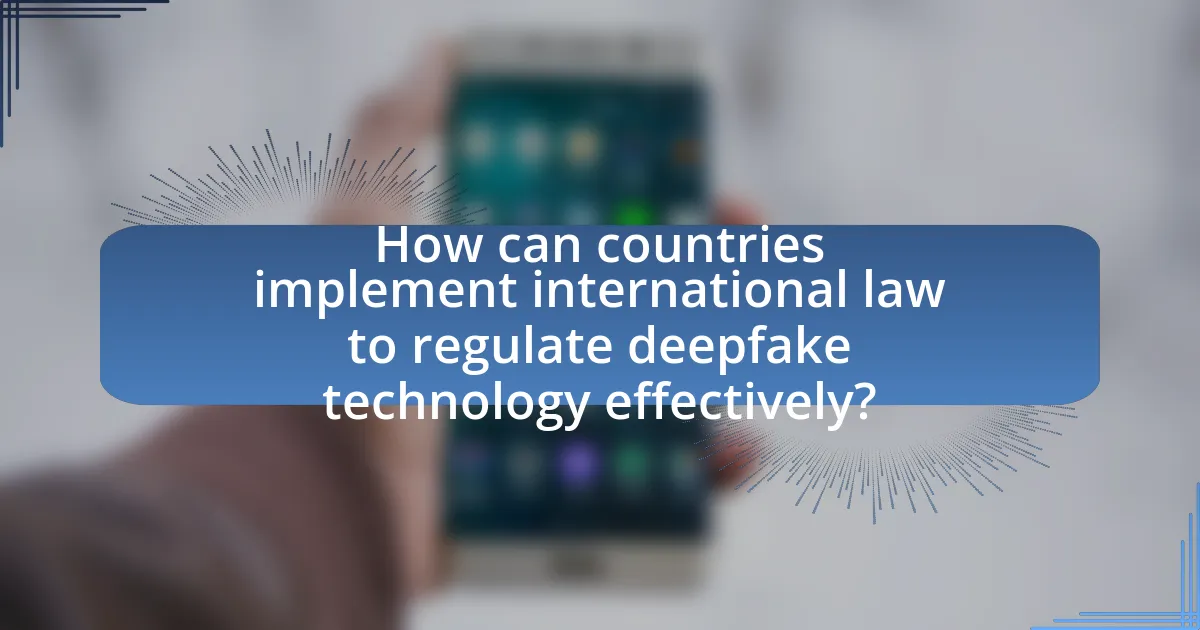
How can countries implement international law to regulate deepfake technology effectively?
Countries can implement international law to regulate deepfake technology effectively by establishing comprehensive legal frameworks that address the creation, distribution, and use of deepfakes. These frameworks should include specific definitions of deepfake technology, legal liabilities for malicious use, and penalties for violations, thereby creating a deterrent against misuse.
For instance, the European Union’s proposed Digital Services Act aims to hold platforms accountable for harmful content, including deepfakes, by requiring them to take proactive measures against misinformation. Additionally, countries can collaborate through international treaties that set standards for the ethical use of artificial intelligence and digital content, ensuring consistency across borders.
Furthermore, countries can enhance enforcement by sharing best practices and resources, as seen in initiatives like the Global Partnership on Artificial Intelligence, which promotes international cooperation in AI governance. By aligning national laws with international standards, countries can create a cohesive approach to regulating deepfake technology, thereby protecting individuals and society from its potential harms.
What best practices can nations adopt for regulating deepfakes?
Nations can adopt several best practices for regulating deepfakes, including establishing clear legal definitions, implementing stringent labeling requirements, and promoting public awareness campaigns. Clear legal definitions help delineate what constitutes a deepfake, thereby providing a framework for enforcement. Stringent labeling requirements mandate that deepfakes be clearly marked as manipulated content, which can mitigate misinformation risks. Public awareness campaigns educate citizens about the existence and potential dangers of deepfakes, fostering critical media literacy. These practices are supported by the growing recognition of deepfakes as a significant threat to information integrity, as evidenced by reports from organizations like the European Commission, which highlights the need for regulatory measures to combat disinformation.
How can countries collaborate to create a unified approach to deepfake regulation?
Countries can collaborate to create a unified approach to deepfake regulation by establishing international treaties that set common standards and guidelines for the use and creation of deepfake technology. Such treaties can facilitate information sharing, best practices, and joint enforcement mechanisms among nations. For instance, the European Union’s proposed regulations on artificial intelligence, which include provisions for deepfakes, can serve as a model for global standards. Additionally, countries can form coalitions to address the challenges posed by deepfakes, as seen in initiatives like the Global Partnership on Artificial Intelligence, which aims to promote responsible AI use. By aligning their legal frameworks and engaging in multilateral discussions, countries can effectively mitigate the risks associated with deepfakes while fostering innovation.
What role does public awareness play in the enforcement of deepfake regulations?
Public awareness significantly enhances the enforcement of deepfake regulations by fostering informed public discourse and encouraging accountability. When individuals are educated about the potential harms and legal implications of deepfakes, they are more likely to report violations and support regulatory measures. For instance, a study by the Pew Research Center found that 86% of Americans believe that deepfakes pose a serious threat to society, indicating a strong public concern that can drive legislative action. Increased awareness can also lead to greater scrutiny of media content, prompting platforms to implement stricter policies against deepfake dissemination. Thus, public awareness acts as a catalyst for both regulatory compliance and the development of more robust legal frameworks surrounding deepfake technology.
What challenges do countries face in enforcing international law on deepfake technology?
Countries face significant challenges in enforcing international law on deepfake technology due to jurisdictional issues, technological complexity, and the rapid evolution of the technology. Jurisdictional issues arise because deepfake content can be created and disseminated across borders, complicating the enforcement of laws that vary from one country to another. For instance, a deepfake created in one nation may violate laws in another, leading to difficulties in prosecution and accountability.
Technological complexity presents another challenge, as the tools and methods used to create deepfakes are constantly advancing, making it hard for legal frameworks to keep pace. This rapid evolution means that existing laws may quickly become outdated or ineffective. Additionally, the anonymity provided by the internet complicates the identification of perpetrators, further hindering enforcement efforts.
Moreover, the lack of a unified international legal framework specifically addressing deepfake technology creates inconsistencies in how different countries approach regulation. This fragmentation can lead to loopholes that malicious actors exploit, undermining the effectiveness of any enforcement measures.
How do technological advancements complicate legal enforcement?
Technological advancements complicate legal enforcement by creating challenges in identifying and prosecuting crimes, particularly with emerging technologies like deepfakes. The sophistication of deepfake technology allows for the creation of highly realistic but fabricated media, making it difficult for law enforcement to distinguish between genuine and manipulated content. For instance, a study by the University of California, Berkeley, found that deepfake detection tools have a high rate of false negatives, meaning that many manipulated videos go undetected, which undermines the integrity of evidence in legal proceedings. Additionally, the global nature of the internet complicates jurisdictional issues, as deepfake creators can operate from different countries, making it harder for local law enforcement to take action.
What are the political and social barriers to effective regulation?
Political and social barriers to effective regulation of deepfake technology include lack of consensus among nations, political interests that prioritize economic benefits over regulation, and public skepticism regarding the necessity of such regulations. The absence of a unified international framework complicates enforcement, as countries may have differing priorities and approaches to technology governance. Additionally, political lobbying from tech companies can influence policymakers to resist stringent regulations, fearing economic repercussions. Socially, misinformation and a general lack of awareness about the implications of deepfakes hinder public support for regulatory measures, making it difficult to mobilize collective action for effective governance.
What practical steps can stakeholders take to navigate the complexities of deepfake regulation?
Stakeholders can navigate the complexities of deepfake regulation by collaborating to establish clear legal frameworks that address the unique challenges posed by deepfake technology. This collaboration should involve governments, technology companies, and civil society to create comprehensive policies that define the legal status of deepfakes, outline penalties for misuse, and establish guidelines for ethical use. For instance, the European Union’s proposed Digital Services Act aims to regulate harmful content online, including deepfakes, by holding platforms accountable for the content they host. Additionally, stakeholders should invest in developing detection technologies to identify deepfakes, which can support enforcement of regulations and protect individuals from potential harm. By engaging in ongoing dialogue and sharing best practices, stakeholders can adapt to the evolving landscape of deepfake technology and ensure effective regulation.
How can individuals and organizations protect themselves from deepfake misuse?
Individuals and organizations can protect themselves from deepfake misuse by implementing advanced detection technologies and promoting digital literacy. Advanced detection technologies, such as AI-based tools, can analyze videos for inconsistencies that indicate manipulation, thereby identifying deepfakes effectively. For instance, a study by the University of California, Berkeley, demonstrated that machine learning algorithms could detect deepfakes with over 90% accuracy. Additionally, promoting digital literacy among employees and the public can help individuals recognize potential deepfake content, reducing the likelihood of falling victim to misinformation. By combining these strategies, both individuals and organizations can significantly mitigate the risks associated with deepfake technology.
What resources are available for understanding and complying with deepfake regulations?
Resources for understanding and complying with deepfake regulations include government publications, legal frameworks, and academic research. Government agencies such as the Federal Trade Commission (FTC) and the European Union provide guidelines and reports on the implications of deepfake technology, outlining legal responsibilities and compliance measures. Legal frameworks like the Digital Services Act in the EU and various state laws in the U.S. specifically address the use of deepfakes, offering clarity on regulatory expectations. Academic research, such as studies published in journals like the Harvard Journal of Law & Technology, provides in-depth analysis and recommendations for compliance with emerging regulations. These resources collectively equip individuals and organizations with the necessary knowledge to navigate the evolving landscape of deepfake regulations.
